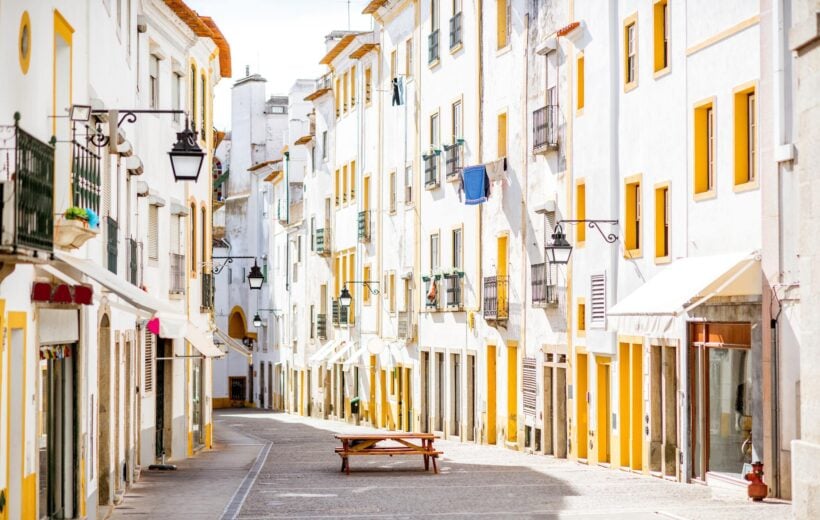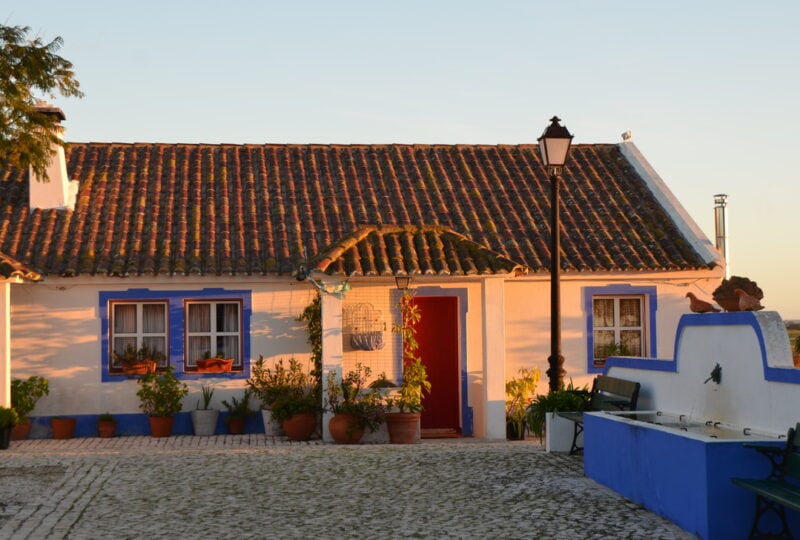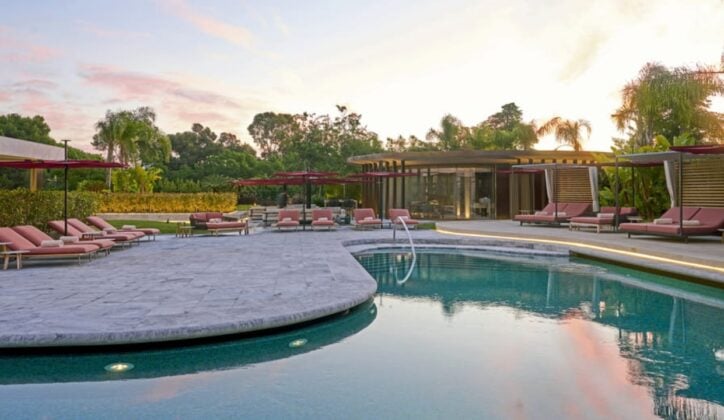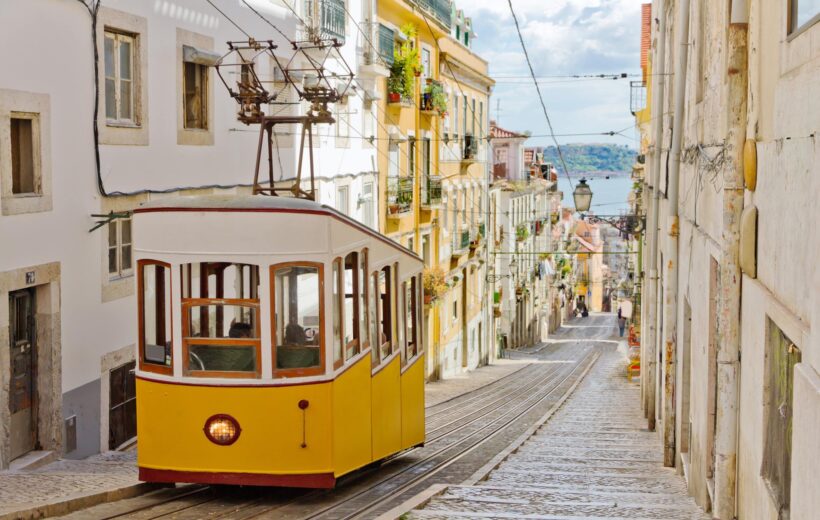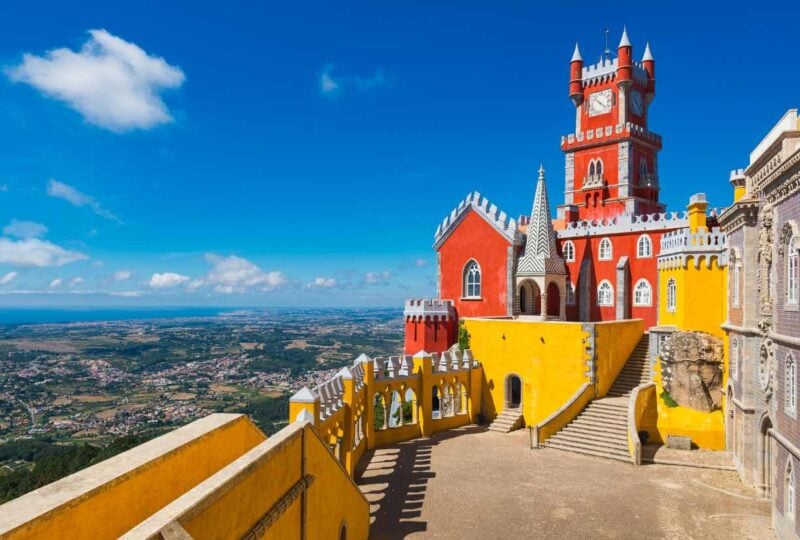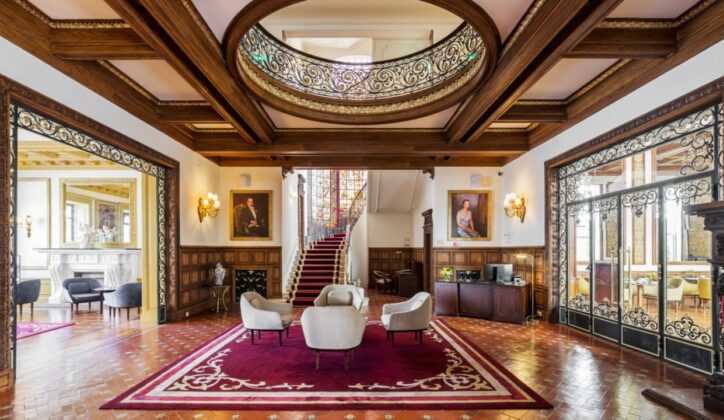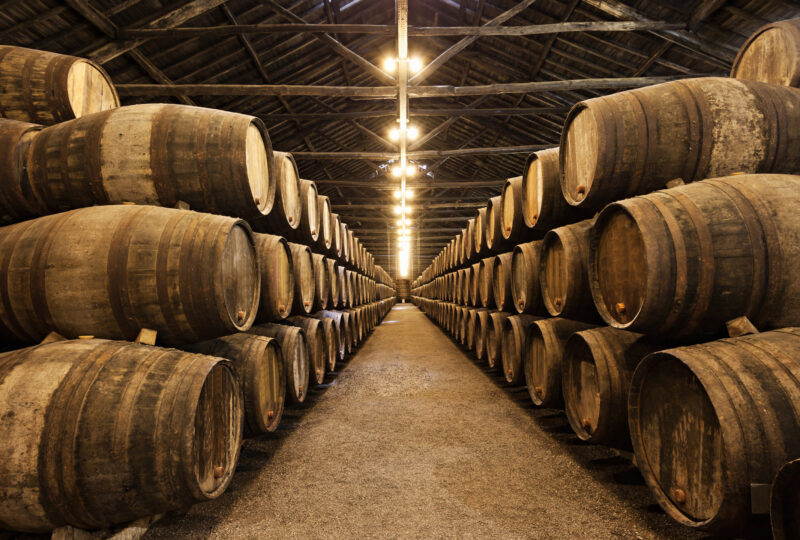The Highlights of Portugal
Trip highlights
- Taste wines at an 18th-century estate in Alentejo
- Explore the 2,000 year old city of Evora
- Experience the power of fado, traditional Portuguese music
- Discover the charming towns of Estoril, Cascais and Sintra
- Tour the city of Porto on foot and by boat
- Sip on the finest vintages of port at Churchill’s and Graham’s
Our bespoke trips include
We design one-of-a-kind journeys incorporating luxury in all its forms. Our bespoke trips include:
- Luxury accommodation throughout
- Privately guided tours
- Private transfers
- Meticulously selected experiences
- Expertise and support from your Jacada Concierge
- Days 1–3 Alentejo
- Days 3–6 Lisbon
- Days 6–9 Porto
- Days 1–3 Alentejo
- Days 3–6 Lisbon
- Days 6–9 Porto
Itinerary in detail
Every Jacada trip is tailored to your personal preferences and interests. Below you’ll find a sample itinerary to inspire your own custom-designed journey.
Two nights in the heart of Alentejo
Covering almost a third of the country, Alentejo is a vast region of cork plantations, wheat fields, vineyards and clusters of historic hilltop towns. Its name means beyond the Tajo, and it stretches south from the River Tajo to the northern mountain ranges of the Algarve encompassing rolling hillsides, rugged peaks, endless plains and sweeping Atlantic beaches.
Vast swathes of sand lay sheltered between rocky cliffs and over 100km of the coastline is part of the South West Alentejo and Costa Vicentina National Park, an area rich in animal and plant life.
Heading inland, Alentejo is littered with Roman ruins, crumbling Moorish castles, marble towns and whitewashed villages. The UNESCO towns of Evora and Elvas are home to baroque bell towers, temples and mighty fortresses, plus there are plenty of smaller atmospheric towns with winding cobbled streets to explore.
Where you could stay
Alentejo
Overview
This exclusive retreat, set in the heart of Alentejo, effortlessly integrates modern architecture into nature. The interiors are designed by Marcio Kogan and feature artworks by Michael Biberstein.
The 22 suites offer you a place to relax surrounded by luxury and the tranquillity and beauty of nature. For a truly stellar romantic experience, choose to sleep beneath the stars in one of the sky suites.
Dine at the Michelin-starred restaurant and go on a gastronomic journey with Miguel Laffan. The menu features Portuguese flavours and ingredients.
Enjoy the outdoors and take a leisurely stroll through the estate’s vineyards, do a wine tasting, or take a tour of the other wine farms in the region.
Find renewal at the Caudalie spa where the treatments carry through the vineyard theme with grape-based products. There are also yoga and meditation sessions on offer, as well as individually designed detox programmes.
→ Find out moreAlentejo
Highlights
- Rooms feature sweeping views of the Alentejo plains
- Indulge in organic and home-grown produce at the property's restaurant
- Relax with a yoga class or a sensory shower
- Enjoy a canoe ride down the Guadiana River
- Tour the expansive estate on foot, horse or quad bike
Overview
Perfectly integrated into the landscape, Herdade da Malhadinha Nova has five guest accommodations, with 26 rooms in total. They portray the various chapters in the history of this family-style project built around wine. Choose from peaceful villas, a country house or spectacular guest suites, many of which feature private balconies and exterior areas with singular views over the Alentejo plains and the outdoor pool.
For dining head to Herdade da Malhadinha Nova’s restaurant which draws inspiration from the local regional cuisine. Here all of the food is created with the organic produce grown on the estate, from the fields, vineyard, olive grove and pastures.
To indulge yourself further, make your way to the M Wellness spa. The treatments here are provided by Azores-born brand IGNAE and focus on specific facial products and body treatments. These use wine, honey and rosemary: three primary ingredients of Herdade da Malhadinha Nova.
The M Wellness Spa also offers experiences combining yoga classes, sensory showers and a sauna along with nutritional lunches made up of organic ingredients produced on the estate. These lunches are paired with wine, olive oil and honey. You can also take part in relaxation therapies or chakra alignment. Outside of the property you can enjoy activities such as an exhilarating balloon ride or skydive, or take it slow with a day spent baking bread and learning artisanal techniques.
→ Find out moreThe impact of your stay:
- As a guest, your stay helps support Malhadinha Nova’s contributions towards local cultural, sports and healthcare institutions.
- Herdade da Malhadinha Nova is located in one of Portugal’s key Special Protection Zones. The stay actively contributes to biodiversity and ecosystem preservation. The estate’s 610 hectares were converted to a biological regime in 2017, receiving official certification in 2020. Most of their wines are fully organic, utilising natural fertilisation, sheep grazing for weed control and species like broad beans and clover to enhance soil and create habitats.
- Guests at the hotel are invited to immersive themselves in local culture through hands-on workshops with skilled artisans, celebrating the richness of local crafts, traditions and cuisine. You can experience the region’s heritage with lively performances and engaging programmes showcasing talented local artists.
Alentejo
Overview
Blending in its surroundings, this modern farmhouse sits minutes to some of Alentejo’s best beaches. Craveiral Farmhouse plays host to 38 self-contained cottages, three swimming pools, one indoor, one restaurant with garden products and organic food, a nature interpretation center, an orchard, a farm with animals, and all the space of the world, between countryside and sea.
The game-changing accommodation operates with sustainability at its very core – from the restaurants’ offerings to the array of activities and experiences made available to guests. There are daily bike excursions, farm animals to entertain small ones all day long, or head out for a surf lesson before coming back to pick your very own vegetables from the on-site garden. The possibilities are endless…
→ Find out moreAlentejo
Overview
Surrounded by a stunning 17-acre estate of umbrella pines, cork trees, wild sand dunes, wildflowers, rice fields and a stretch of pristine, white-sand beach, Sublime Comporta is a fabulous contemporary retreat a little over an hour from Lisbon.
There are 14 white, minimalist, rustic bedrooms spread between the main building and a nearby annex, as well as a selection of beautiful 2, 3 and 5 bedroom ‘cabana’ villas.
The chic restaurant, Sem Porta, celebrates seasonal local produce and producers in a relaxed, modern setting. Think fresh oysters and sea bass with herbs and vegetables from the organic twinned with wonderful regional wine. There’s also a cocktail bar as well as another drinks venue by the swimming pool.
Activities in the surrounding areas include horse-back riding on the dunes, fields and deserted beaches of Comporta, picnics on private lakes, excursions out with a local fisherman, wine tasting and excursions to discover Portugal’s only resident dolphin community, though sitting back and relaxing is the order of the day here. Sublime Comporta’s spa offers a wide variety of treatments in indoor and outdoor treatment rooms, a sauna, steam bath and a heated indoor pool with all organic products.
→ Find out moreThe highlights of Alentejo
Quinta Dona Maria
This palace-like 18th-century estate is world-renowned for its beauty and the quality of its wines. At one point, it was acquired by King João V as a gift for Dona Maria, a lady of the court with whom he was madly in love. Explore the grounds and the gorgeous walled garden, learning the stories of the aristocrats that once spent hot summer afternoons here. Inside, the owner will invite you to enjoy a wine tasting and traditional lunch.
Exploring Evora
A UNESCO World Heritage Site known as the ‘museum city’, Évora traces some 2000 years of history. On your private tour, start in the main square, Praça do Giraldo, the heart of the city where you can see the 16th Century St. Anton’s Church. Beyond, explore the Gothic and Manueline influenced Church of St. Francis and the Capela dos Ossos, the Chapel of Bones. Évora’s Cathedral, by far the most dominating site in the whole town and the largest cathedral in Portugal.
Herdade da Mata Farm
At the Herdade Da Mata farm, we’ll arrange a tour and a picnic lunch. The Swiss owners live on the grounds and are delighted to share life on a typical Alentejo farm, from breeding cattle horses and goats to running the equestrian school. You will have the opportunity to meet endangered Garvonesa cows, enjoy spectacular views and spot many different species of birds.
Where you could stay
Lisbon
Highlights
- 4 restaurants and lounges
- In room dining options
- 2 swimming pools (outdoor and indoor)
- Spa
- Fitness centre
- Rooftop running track
- Pilates studio
Overview
Located in the heart of the Lisbon, at the top of one of the city’s famous seven hills, the Four Seasons Hotel Ritz offers spectacular views across the city and river.
282 rooms and suites are beautifully decorated with 18th-century style furnishings as well as tapestries, painting and sculptures by contemporary Portuguese artists. Most rooms come with a private balcony overlooking the hotel gardens, Eduardo VII Park or the River Tajo so you can enjoy bird’s-eye-views and wonderful sunsets over the city’s rooftops.
One of Lisbon‘s gastronomic gems, the Verandah restaurant serves fresher-than-fresh seafood caught from the nearby Atlantic Ocean and boasts an impressive wine cellar. For those with a keen interest in cooking, the hotel can arrange tastings, visits to the fish market and cooking classes. There is a also a sushi bar for fresh, healthy bites.
Named after the famous Portuguese artist, Jose Almada Negreiros, the hotel lounge is a favourite haunt for guests and locals alike. The centrepiece of the Ritz bar is Pedro Leitao’s piano, which has been signed by world-famous artists. Take a seat under one of the hand-made Centauros tapestries or head out onto the terrace to drink in the views.
There is a spa featuring an indoor pool and treatment rooms for when you want to completely unwind, as well as a rooftop fitness centre and running track for those who like an active start to their day.
There are 60 pieces of art throughout the hotel and privatley guided tours can be arranged for guests to learn more about them and their history.
→ Find out moreLisbon
Highlights
- Restaurant and bar
- Boutique spa
- Wine tasting
- Classic and sophisticated decor
Overview
Located in the heart of Lisbon in the captivating Chiado, Bairro Alto and Príncipe Real neighbourhoods, facing the breathtaking panoramic views of the São Pedro de Alcântara Viewpoint and the emblematic Glória Tram, you’ll find the stunning Palácio Ludovice hotel.
The property is a former private residence of João Federico Ludovice, architect to King João V in the 18th century and the restoration has been sympathetic to original features and character. The decor is classic, sophisticated and with depth and warmth in the choice of colour and soft furnishings that gives an eclectic and intriguing feel.
The hotel has 61 rooms and suites. There are 4 room categories, some offering multiple windows and balconies with unparalleled city views while others have gorgeous interior courtyard sights. There are 3 categories of elegant suites with spacious marble bathrooms and large windows featuring walk-in rain showers and tubs.
Dining at the hotel is a wonderful experience with food and wine given much thought and appreciation. The courtyard at Palácio Ludovice is the rendezvous place for food lovers and wine connoisseurs. The hotel’s facilities also include a spa and wellness area that exudes peace and serenity with signature wellness treatments and a carefully curated boutique shop with a selection of the most exclusive products and a fully equipped gym.
→ Find out moreLisbon
Overview
Surrounded by the forests of Sintra-Cascais Natural Park, you’d never guess this sprawling resort was just 30 minutes from the centre of Lisbon.
Encompassing a 19th-century palace originally founded as a monastery in the 14th century, 27 Robert Trent Jones Jr. designed golf holes amid within historic ruins and a modern spa and wellness center, the Penha Longa Resort is a fine base out of the city.
There are 194 stylish rooms, all with balconies, six restaurants, indoor and outdoor swimming pools and acres of grounds to explore.
During your time here, venture into the capital city, discover the national park or head to nearby Estoril and Cascais beaches for a surfing lesson. Families are also well catered for here with a kid’s club.
→ Find out moreSee Lisbon in luxury
Europe’s second-oldest capital, Lisbon is an effortlessly elegant city, full of old-world charm. Winding your way through its streets, you’ll pass rows of houses in warm shades of orange, yellow and rust red. Washing is strung from wrought iron balconies and window boxes overflow with flowers. Weaving their way through this pretty patchwork are the city’s trams, a great way to hop between the different districts.
There’s lots to see as you explore with an expert local guide: a plethora of museums and galleries as well as beautiful buildings covered in azelujo tiles. The city is built on seven hills, each one offering spectacular views, and is known for its lively restaurant scene. There are plenty of places to stop, sip a coffee and savour a Portuguese custard tart.
Outside the city, you can spend a day discovering the charming traditional towns of Estoril, Cascais and Sintra.
Sightseeing and culture
A historical tour of Lisbon
Your private tour will allows you to dig deeper into the history of Portugal’s capital. Visit the Castle of Saint Jorge and Alfama, Lisbon’s oldest quarter, before learning about the heroic deeds of the Portuguese maritime exploration in the 15th and 16th centuries. This was the Golden Era of Portugal, when Lisbon transformed into the opulent center of a vast empire. Monuments from this era can still be seen today.
Visit Sintra, Cascais and Estoril
In Sintra, hundreds of years of history and culture await. You’ll walk through the city centre and visit the 19th-century Pena Palace, the greatest expression of 19th-century romanticism in Portugal. Cascais is a coastal town, once a small fishing village, that became popular with artists and writers thanks to its idyllic scenery. You will also have time to explore the pretty seaside resort of Estoril.
Enjoy a fado performance and dinner
Many Portuguese would argue that you can’t truly know their country without hearing and understanding the traditional music. Fado is the melancholic song of Portugal, usually performed in a dark tavern by a singer and a small band of guitars, violas and basses. Tonight, you will be welcomed into the soul of Portugal in one of Lisbon’s most emblematic fado locales for a traditional Portuguese meal and a show.
Explore Tomar and Fatima
Venture out of Lisbon to visit Tomar, one of Portugal’s most historic cities. Its Templar Castle and Christ Convent became the national headquarters of the Templar Knights in the middle ages, and later was at the forefront of the Order of Christ. In Fatima, visit one of the most important catholic shrines in the world dedicated to the Virgin Mary, which welcomes millions of pilgrims and tourists from all over the world.
Three nights in Portugal's second city
Porto is one of Europe’s most charming cities. Built on a steep riverbank, its jumble of colourful medieval houses hug the calm waters of the Douro River where wooden boats bob on the surface and people spill out of its cafes and bars.
Once you’ve settled into your accommodation, you’ll be joined by a guide for a walking tour of the city, followed by a boat tour. Enjoy the views of the old town and bridges as you slip by in the fading evening light.
Finally, raise a glass or two of port to an amazing Portuguese trip as you visit Churchill’s and Graham’s Port Wineries and sample some of their finest vintages. What better way to bring your adventure to a close?
Where you could stay
Porto
Highlights
- 109 rooms and suites
- Rooftop swimming pool
- Spa
- Two gourmet restaurants
Overview
This hotel was the family home of the Yeatmans, the British owners of a large port business. A hillside position on the banks of the River Douro in the heart of Vila Nova de Gaia and next to ancient port houses puts the hotel in a prime position for epic views and interesting activities.
The decor is classic and elegant, in keeping with the family’s heritage. The 109 rooms and suites feature antique artefacts and pictures from different Portuguese wine producers, opening out onto private balconies overlooking the river and the city’s historic centre. Be immersed in the city’s culture in the ADF Suite, where the bed head is an original barrel top and the domed oak ceiling mimics the enormous oak barrels used in wine production.
A highlight of a stay at The Yeatman is dining at the two gourmet restaurants. Enjoy imaginative cuisine where the traditional flavours are reinterpreted and presented immaculately. The restaurant is bright and airy and offers spectacular views over the river. There’s a comprehensive list of Portuguese wines and food and wine pairing menus take you on a journey through Portugal’s diverse and varied wine regions.
Relax and unwind at the hotel spa which offers a range of rejuvenating treatments, using natural ingredients from the surrounding vineyards. There is also an indoor and outdoor rooftop pool – take a dip in the evening and admire the twinkling lights of the city laid out before you.
→ Find out morePorto
Overview
Indulge in sophisticated luxury amid elegant surroundings at InterContinental Porto – Palacio das Cardosas in the centre of Porto. The exquisitely restored interiors speak of the palace’s grand past.
The 105 charming and spacious rooms and suites offer views out over peaceful enclosed gardens, Liberdade Square and the Clerigos Tower. The design is contemporary, making for comfortable inner-city havens. Chic suites boast living rooms, and balconies with views out over the Porto skyline.
Dine in style at Astoria Restaurant, where the menu features traditional Mediterranean and Portuguese cuisine with modern flourishes. Local, seasonal ingredients ensure the richness of the traditional flavours is preserved. As the sun goes down sip on cocktails and port wines in the elegantly stylish Cardosas Bar. Styled on a British library, this is also where you’ll find an indulgent afternoon tea.
When you are not out exploring the fascinating city, relax with a spa treatment or two, or fit in a work out in the fitness centre.
→ Find out morePorto
Highlights
- 85 fully appointed bedrooms and suites
- 8 room categories
- VOGUE Cafe with bar, restaurant and patio
- Room service
- Concierge desk
- Elevators
Overview
Nestled in the heart of the vibrant city of Porto, Portugal, Infante Sagres has been a symbol of sophistication and refinement since its establishment in 1951.
As you step through the grand entrance, you’ll immediately be captivated by the hotel’s magnificent architecture, which blends classic design elements with contemporary touches. The meticulously restored interior showcases a seamless fusion of opulence and comfort, creating an ambiance that exudes both grandeur and intimacy.
There are 85 rooms and suites in total – all of which have been refurbished to bring the Infante Sagres back to its former glory as Porto’s premier historic luxury hotel. Guests can choose from 8 different rooms types, some with spectacular views over the historic city of Porto.
Infante Sagres also plays host to the elegant and stylish Vogue Café – a space which invites you to step inside the Vogue world – a world of excitement, luxury and timeless elegance. Discover their all-day menu featuring the best in contemporary European cuisine as you take in the décor that feels like it has been lifted directly from the pages of the magazine.
With its prime location, the hotel serves as the perfect base for exploring the charms of Porto. When it’s time to step outside, bask in the beauty of Neoclassical structures and statues as you stroll down Avenida dos Aliados. Or go back to the Ribeira neighborhood, where the city first began, stopping to admire the views from the hilltop cathedral. In the evening, head back to the hotel to experiment with one of their fabulous, freshly prepared cocktails or choose from an extensive list of fine wines and champagnes.
→ Find out moreThe best of Porto
Sightseeing
Sailing
Drinking
Drinking
A private tour of Porto
This tour is a great introduction to Porto, its history and its cultural treasures. Discover medieval relics, soaring bell towers, extravagant baroque churches and stately beaux-arts buildings piled on top of one another. Along the way you’ll visit landmarks such as the Stock Exchange Palace, the Church of Saint Francis, the Cathedral and the ornate Lello Bookstore in the historic Ribera district.
An evening on the Douro
The best way to discover the romantic and mythical city of Porto is from the water. Cruise along the Douro River on your private boat and enjoy a glass of local wine as the views of soaring bell towers, baroque churches, and stately beaux-arts buildings are illuminated by the last rays of the sun. Once the sun has set, the lit-up homes seem to dance along Porto’s hills, and the city takes on a whole new character.
Tasting the finest ports
Churchill’s winery was founded by John Graham in 1981, and was the first British port wine company to be established in 50 years. It was named for. his wife, Caroline Churchill. Their unique ports are produced from vineyards on the south bank of the River Douro, in the prestigious Cima Corgo sub-region. You’ll also stop for a tasting the historic Graham’s winery, built in 1890 on a hilltop in Vila Nova de Gaia, a strategic location between river, ocean and the lush green hills.









